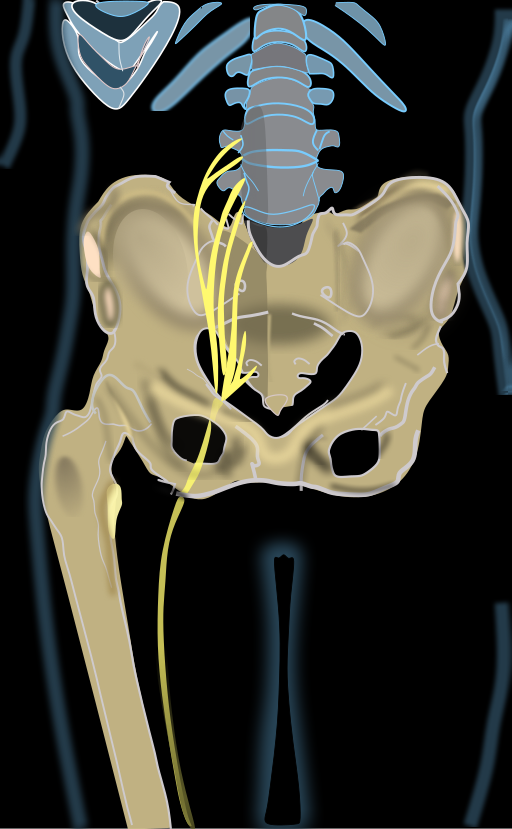“Sciatica” describes the pain associated with the sciatic nerve. This nerve is the longest and thickest nerve in the body. Sciatica pain may stem from an injury, an underlying illness, or irritation.
While injuries to this nerve are rare, the term is often used to describe any pain that starts in the lower back and radiates down into the thigh and leg.
Physical Therapy is considered the best treatment for the irritation of this part of the body.

Where is the Sciatic Nerve Located?

The sciatic nerve starts at the base of the spine and then runs down the backs of each leg and goes directly into the foot. At its point of origination, there is a mixture of both motor fibers and sensory fibers on the spinal-based nerves of L4 all the way to S3. These result in the formation of the sciatic nerve.
The sciatic nerve is protected in this area by the muscles of the buttocks. While it cannot be felt by pressing in on the skin, individuals who have an impairment with the sciatic nerve are likely to find that their leg may feel quite stiff and even find that there is a lack of flexibility.
The nerve continues to run down the back of the thigh, back of the leg, and down into the foot, where it ends.
Does Sciatic Nerve Irritation Occur in Both Legs?
In most instances, an irritation of the nerve affects only one leg at a time; however, it is not impossible for the issue to occur in both legs at the same time. It all depends on where the nerve is being irritated within the spinal column.
What Does Sciatic Nerve Pain Feel Like?
Sciatic nerve pain may be described in many different ways. The underlying cause has a direct correlation on the sensation experienced.
Examples of descriptions most often described when the nerve is irritated include “sharp”, “shooting”, “burning”, “electric”, and/or “stabbing”.
The pain may be constant or come and go.
In most instances, the most severe pain will occur within the leg. Many find that sitting or standing for long periods causes the most intense pain. Additionally, sudden body movements such as twisting the upper body, coughing, and even sneezing may increase the amount of pain experienced.

Does Sciatic Nerve Pain Happen Fast or Does it Happen Gradually?
It is possible for the pain of the sciatic nerve to happen fast or come on gradually – it all depends on the cause. For example, if you herniate a disc in the spine, it may occur suddenly. If you have arthritis within the spine, the pain may develop gradually.
Is Sciatic Nerve Pain Common?
Yes, according to medical doctors and numerous studies, sciatic nerve pain will affect 40% of all people at least once during life. Additionally, it has been established that back pain is the third most common culprit behind visiting doctors within the United States.
What are the Most Common Causes of Sciatic Nerve Pain?
There are many underlying causes of sciatic nerve pain. The following outlines the most common:
- Bulging Disc
- Herniated Disc
- Spinal Stenosis
- Degenerative Disc Disease
- Spondylolisthesis
- Osteoarthritis
- Trauma / Injury
- Tumors That Compress the Nerve
- Piriformis Syndrome
- Neuromuscular Disorders
- Cauda Equina Syndrome
- Being Overweight and/or Obese
- Weak Core Muscles
- Heavy Lifting
- Prolonged Sitting
- Posture Issues
- Diabetes
- Inactive Lifestyle
- Using Products Containing Alcohol
What are the Symptoms of Sciatic Nerve Pain?
If the sciatic nerve becomes irritated, the following symptoms may occur:
- There may be moderate to highly severe pain within the areas of the lower back, the buttocks, and down into and throughout the leg.
- It is common for sciatic nerve irritation to result in weakness and numbness within the lower back, through the buttocks, in the legs, and even in the feet.
- Sciatic nerve pain may occur and worsen with movement. In fact, the pain may become so severe that a loss of movement actually occurs.
- The legs, the feet, and/or the toes may start to develop sensations that resemble that of pins and/or needles pressing in on the skin.
- There may be a development of loss of bladder and/or bowel control if the sciatic nerve is severely irritated.
What is the Goal of Sciatic Nerve Treatment?
Ultimately, the goal of treatment for sciatica is to increase the mobility of the body while decreasing the amount of pain that is experienced.
What is the Best Treatment for Sciatica?
There are many self-care treatments including applying ice and hot packs, taking over-the-counter medications, and stretches. There are also medical treatments such as prescription medications, spinal injections, and surgery.
It is generally agreed to by all that the best treatment for sciatica is physical therapy.
What Types of Physical Therapy Treatments are Effective for Sciatica?
Physical therapists work with sciatica patients to uncover exercises and physical activities that decrease the pain that they experience by reducing the amount of pressure that is placed on the sciatica nerve.
In most instances, stretching exercises are extremely common. These aid in improving the overall flexibility of the muscles.
Additionally, aerobic exercises – such as walking and swimming – are performed in physical therapy programs to help ease the pain of an irritated sciatic nerve.
You may even be encouraged to engage in other activities – such as dry needling, and working out on an antigravity treadmill to reduce your overall discomfort.
Physical therapists will work closely with you to create a customized, personal treatment plan that is based on your medical history and current state of physical health. This will be a treatment plan that will include stretching exercises, core strengthening exercises, activities that improve your range of motion, and even aerobic exercises.
When used together, all of these activities will successfully reduce the amount of pressure that is placed on the sciatic nerve. In turn, it lessens the irritation of the nerve until the pain is completely eliminated.

Are There Alternative Therapies That May be Used with Physical Therapy for Sciatic Nerve?
Yes, there are several alternative therapies that may be used along with physical therapy to reduce the pain of the sciatic nerve.
These include spinal manipulation by a chiropractic care specialist, massage therapy to reduce muscle spasms that often occur with sciatica, yoga, acupuncture, and even biofeedback for the purpose and intent of managing pain and relieving the stress that may be leading to the development of the nerve problem.
To learn more about which would be best for your needs, you should ask the physical therapist that you choose to work with to overcome sciatic nerve pain.
Get Started Immediately
Have you been diagnosed with sciatica? Are you tired of experiencing the pain and discomfort associated with the condition? Would you like to quit taking medications for the issue that cause uncomfortable side effects? If you answered “yes” to any of these questions, it is time for you to contact us here at Back to Motion Physical Therapy!
We will work closely with you to uncover the most common culprit of your suffering and create a personalized treatment plan tailored to your individual needs. In addition to standard treatments, we also offer a wide assortment of services that will optimize your health and transform your life!
